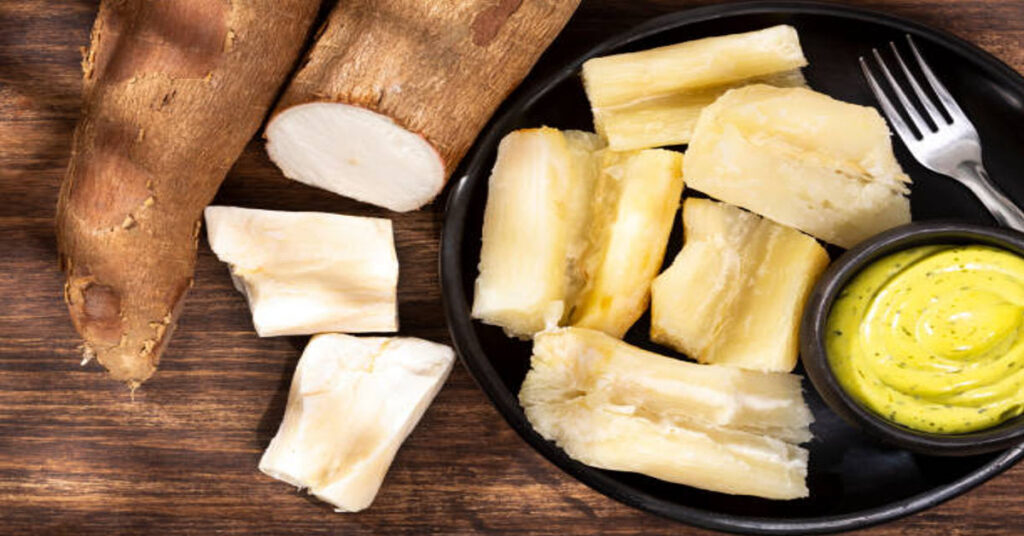Yuca, also known as cassava or manioc, is one of the most widely consumed root vegetables in the world. It has sustained populations for centuries, serving as a staple food in many tropical regions of Africa, South America, Asia, and the Caribbean. Despite its humble appearance, yuca holds a rich cultural, nutritional, and culinary significance. In English-speaking regions, the term yuca often causes confusion with yucca, a desert plant with spiky leaves that is unrelated to the edible root.
Understanding what yuca truly is involves exploring its origins, nutritional composition, health benefits, preparation methods, and the vital role it plays in food security and traditional cuisine. This comprehensive article dives deep into all these aspects, giving you a clear and insightful look at this versatile root.
1. What Is Yuca?
Yuca (pronounced YOO-kah) is a starchy, tuberous root vegetable that grows underground, much like potatoes or sweet potatoes. It comes from the Manihot esculenta plant, which belongs to the spurge family (Euphorbiaceae). The plant itself features long, slender stems and broad green leaves, but its true value lies in its thick, brown-skinned root.
The flesh of the yuca root is firm and white, with a texture that varies from waxy to fibrous depending on the variety. Yuca is known for its mild, slightly nutty flavor and dense starch content, which makes it a major source of carbohydrates for millions of people globally.
It is one of the most drought-resistant crops in the world, thriving in poor soils where other plants fail. This resilience has made it essential to food systems in tropical and subtropical regions, particularly in developing countries where it helps combat hunger and malnutrition.
2. The Difference Between Yuca and Yucca
Many English speakers confuse yuca with yucca due to the similarity in spelling and pronunciation. However, they are entirely different plants.
| Feature | Yuca (Cassava) | Yucca (Desert Plant) |
|---|---|---|
| Scientific Name | Manihot esculenta | Yucca filamentosa (and related species) |
| Type of Plant | Root vegetable | Ornamental desert shrub |
| Edible Part | Underground tuber (root) | Occasionally, flowers or fruits |
| Native Region | South America | North and Central America |
| Primary Use | Food source (boiled, fried, ground) | Decorative or medicinal |
| Texture and Taste | Starchy and mild | Not edible in root form |
So, when talking about the food item cooked in many tropical dishes, the correct term is yuca, not yucca.
3. Origin and Global Importance
Yuca is believed to have originated in South America, particularly in the Amazon Basin, where indigenous tribes domesticated it thousands of years ago. Early civilizations such as the Mayans and the Tupi-Guarani people relied on yuca as a staple food long before European contact.
Over time, it spread across Africa and Asia through trade and colonization. Today, it is a global crop, grown in over 100 countries. According to agricultural records, yuca ranks as the third-largest source of carbohydrates in tropical regions after rice and maize.
In Africa, it is a lifesaving crop due to its ability to withstand drought and poor soil conditions. In Latin America, it remains an essential cultural ingredient—featured in dishes like arepas, pão de queijo, and yuca frita. In Asia, particularly in Thailand and Indonesia, it is used to make flour, snacks, and desserts.
4. Types of Yuca: Sweet and Bitter Varieties
There are two main types of yuca—sweet yuca and bitter yuca. They differ primarily in their cyanogenic glycoside content, which can produce hydrogen cyanide when consumed raw.
| Type | Description | Cyanide Content | Common Uses |
|---|---|---|---|
| Sweet Yuca | Mild, easy to cook, safe for direct boiling or frying | Low | Home cooking, fresh consumption |
| Bitter Yuca | More fibrous and bitter in taste, requires processing | High | Flour, starch, animal feed, industrial uses |
Both varieties are safe to eat once properly prepared. The traditional processing methods—such as soaking, drying, fermenting, or cooking—neutralize any natural toxins.
5. Nutritional Composition of Yuca
Yuca is primarily valued for its high carbohydrate content, making it a reliable energy source. It is naturally gluten-free and low in fat and protein, which makes it suitable for people with dietary restrictions or gluten sensitivity.
| Nutrient (per 100g of cooked yuca) | Approximate Amount |
|---|---|
| Calories | 160 kcal |
| Carbohydrates | 38 g |
| Protein | 1.4 g |
| Fat | 0.3 g |
| Fiber | 1.8 g |
| Calcium | 15 mg |
| Potassium | 270 mg |
| Vitamin C | 20 mg |
| Iron | 0.3 mg |
Because it’s rich in carbohydrates and electrolytes like potassium, yuca provides steady energy and helps maintain hydration and muscle function. However, due to its low protein content, it is often paired with legumes, fish, or meat in balanced diets.
6. Health Benefits of Yuca
Yuca offers several nutritional and health benefits, making it more than just a starchy filler.
A. Excellent Energy Source
Yuca’s high carbohydrate content makes it ideal for individuals needing sustained energy. It’s commonly consumed by athletes or those in physically demanding jobs.
B. Gluten-Free Alternative
For people with celiac disease or gluten intolerance, yuca serves as an excellent substitute for wheat-based products. Cassava flour and tapioca starch, derived from yuca, are now staples in gluten-free baking.
C. Supports Digestive Health
The root contains dietary fiber that aids digestion and helps regulate bowel movements. Fiber also contributes to a sense of fullness, which can help manage appetite.
D. Promotes Healthy Skin and Immunity
Its Vitamin C content supports collagen production and boosts immunity, protecting the body from oxidative stress and infections.
E. Helps Maintain Electrolyte Balance
Rich in potassium, yuca assists in balancing electrolytes, regulating blood pressure, and supporting heart health when consumed moderately.
7. Potential Risks and Precautions
Although yuca is nutritious, improper preparation can make it harmful. The raw root contains compounds that can release cyanide, especially in the bitter variety. Therefore, it must always be cooked thoroughly.
Safety Guidelines:
- Never eat raw yuca.
- Peel and wash the root before cooking.
- Boil or fry completely until tender.
- Avoid excessive consumption of bitter yuca unless processed into flour or starch.
Following these guidelines ensures that yuca remains both delicious and safe to eat.
8. How to Prepare and Cook Yuca
Preparing yuca requires patience and care. Below is a step-by-step guide for safe and tasty results.
Step 1: Peeling
Use a sharp knife to cut off both ends, then slice through the thick, waxy brown skin lengthwise. The outer layer peels off in long strips to reveal the firm white interior.
Step 2: Boiling
Cut the peeled root into chunks and boil for 20–30 minutes until soft. Salt can be added to enhance flavor. The cooked root becomes slightly translucent and tender.
Step 3: Frying
Once boiled, you can slice and fry yuca to make crispy yuca fries or chips. Frying brings out a golden color and nutty taste.
Step 4: Mashing or Baking
Boiled yuca can also be mashed like potatoes, blended into soups, or baked into casseroles and cakes.
Common Cooking Methods Table
| Method | Purpose | Texture Result |
|---|---|---|
| Boiling | Softens the root for direct eating or mashing | Soft, creamy |
| Frying | Creates crispy fries or chips | Crunchy outside, soft inside |
| Baking | Used in casseroles, breads, and snacks | Firm and hearty |
| Steaming | Keeps nutrients intact | Tender and moist |
9. Culinary Uses Around the World
Yuca is remarkably versatile. Its mild taste allows it to adapt to a wide variety of cuisines.
A. Latin America
In countries like Colombia, Venezuela, and Brazil, yuca is a dietary cornerstone. Dishes include:
- Yuca frita – fried yuca sticks, similar to French fries.
- Pão de queijo – Brazilian cheese bread made from cassava flour.
- Casabe – flatbread made from ground yuca.
B. Africa
In Nigeria and Ghana, yuca (locally called cassava) is ground into flour to make garri or fufu, starchy pastes served with soups and stews.
C. Asia
In Thailand, Indonesia, and the Philippines, yuca is used in desserts and snacks such as cassava cake, tapioca pearls, and sweet puddings.
D. The Caribbean
Yuca forms part of Caribbean comfort foods like bammy (Jamaican flatbread) and yuca con mojo (Cuban-style yuca with garlic sauce).
Each region transforms yuca into a cultural expression—proving that this humble root is both universal and deeply local.
10. Yuca Products and Derivatives
Yuca’s adaptability extends beyond whole-root cooking. Its derivatives form the base of numerous commercial and household products.
| Product | Description | Common Uses |
|---|---|---|
| Cassava Flour | Finely ground flour from dried yuca | Gluten-free baking, thickening agent |
| Tapioca Starch | Extracted starch from yuca | Puddings, pearl tapioca, sauces |
| Cassava Chips | Thinly sliced fried yuca | Snack alternative to potato chips |
| Yuca Bread and Crackers | Made using cassava flour | Gluten-free bread substitutes |
The ability to transform yuca into diverse products has made it vital to both household kitchens and food industries.
11. Storage and Preservation
Fresh yuca roots do not store as well as dried or processed forms. They begin to deteriorate within a few days due to high moisture content.
Storage Tips:
- Fresh: Store unpeeled roots in a cool, dry place for up to 3–5 days.
- Refrigerated: Wrap peeled yuca in water-filled containers and refrigerate for up to a week.
- Frozen: Boil, drain, and freeze in airtight bags for several months.
For long-term storage, yuca is often dried and ground into flour, which lasts for months without losing nutritional value.
12. Environmental and Economic Importance
Yuca contributes significantly to food security and economic stability, especially in developing nations. It grows in poor soils, needs little fertilizer, and withstands drought, making it one of the most climate-resilient crops available.
Farmers value it as a dependable crop that can survive extreme weather. Its by-products—like cassava peel and stems—are used as animal feed or organic compost, minimizing waste.
Economically, the cassava industry supports millions of small-scale farmers. Processed products like tapioca starch and ethanol from cassava roots are valuable export commodities, boosting rural economies.
13. Yuca and Modern Nutrition Trends
In recent years, yuca has gained attention in health-conscious communities. It fits perfectly within gluten-free, paleo, and whole-food diets. Cassava flour is now a common ingredient in gluten-free pancakes, pizza crusts, and pastries.
Because it’s free of common allergens and highly digestible, it serves as a great substitute for wheat or corn products. Moreover, its resistant starch content—especially in cooled, cooked yuca—can support gut health by promoting beneficial bacteria.
14. Interesting Facts About Yuca
- Yuca is also called manioc, cassava, or mandioca in different regions.
- It can grow up to 3 meters (10 feet) tall.
- Tapioca pearls used in bubble tea are made from yuca starch.
- During World War II, cassava flour was used as a wheat substitute.
- One hectare of cassava can yield more food energy than almost any other crop.
15. Common Misconceptions About Yuca
Myth 1: Yuca is the same as yucca.
Fact: They are different plants; yuca is edible, yucca is ornamental.
Myth 2: Yuca is only for poor countries.
Fact: It’s used worldwide in modern, gourmet, and gluten-free dishes.
Myth 3: Yuca is unhealthy because it’s starchy.
Fact: In moderation, it’s a valuable energy source with essential vitamins and minerals.
Conclusion
Yuca is far more than a simple root vegetable—it is a global symbol of resilience, nourishment, and adaptability. From the Amazon rainforests to African farmlands and Asian kitchens, yuca provides sustenance to millions. It nourishes not only the body but also cultural identity and food traditions.
When understood, prepared, and enjoyed properly, yuca offers a healthy, versatile, and eco-friendly alternative to common carbohydrate sources. Whether served boiled, fried, or transformed into flour, it remains a testament to how nature’s simplicity can yield incredible nourishment.
FAQs
1. What is yuca in English?
Yuca, also known as cassava or manioc, is a starchy root vegetable native to South America and widely eaten globally.
2. Is yuca safe to eat raw?
No. Raw yuca contains natural toxins that must be destroyed through proper cooking or processing.
3. How do you cook yuca?
Peel, chop, and boil the root until soft. It can then be fried, mashed, or baked depending on the recipe.
4. What are the health benefits of yuca?
Yuca provides energy, fiber, and vitamin C, supports digestion, and serves as a gluten-free alternative to grains.
5. Can yuca be used for baking?
Yes. Cassava flour made from yuca is widely used for gluten-free baking, producing light and chewy textures.







